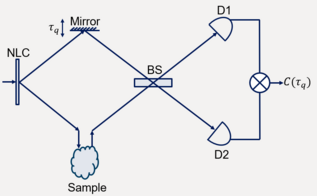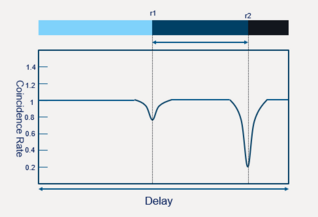Physics:Quantum optical coherence tomography
Quantum optical coherence tomography (Q-OCT) is an imaging technique that uses nonclassical (quantum) light sources to generate high-resolution images based on the Hong-Ou-Mandel effect (HOM).[1] Q-OCT is similar to conventional OCT but uses a fourth-order interferometer that incorporates two photodetectors rather than a second-order interferometer with a single photodetector.[2] The primary advantage of Q-OCT over OCT is insensitivity to even-order dispersion in multi-layered and scattering media.[3][4][5]
Several quantum sources of light have been developed so far. An example of such nonclassical sources is spontaneous parametric down-conversion that generates entangled photon pairs (twin-photon).[6] The entangled photons are emitted in pairs and have stronger-than-classical temporal and spatial correlations. The entangled photons are anti-correlated in frequencies and directions. However, the nonclassical light sources are expensive and limited, several quantum-mimetic light sources are developed by classical light and nonlinear optics, which mimic dispersion cancellation and unique additional benefits.[7]
Theory
The principle of Q-OCT is fourth-order interferometry. The optical setup is based on a Hong ou Mandel (HOM) interferometer with a nonclassical light source. Twin photons travel into and recombined from reference and sample arm and the coincidence rate is measured with time delay.[8]
The nonlinear crystal is pumped by a laser and generates photon pairs with anti-correlation in frequency. One photon travels through the sample and the other through a delay time before the interferometer. The photon-coincidence rate at the output ports of the beam splitter is measure as a function of length difference ([math]\displaystyle{ c\tau_q }[/math]) by a pair of single-photon-counting detectors and a coincidence counter.
Due to the quantum destructive interference, both photons emerge from the same port when the optical path lengths are equal. The coincidence rate has a sharp dip when the optical path length difference is zero. Such dips are used to monitor the reflectance of the sample as a function of depth.[9]
The twin-photon source is characterized by the frequency-entangled state:
[math]\displaystyle{ \left | \psi \right\rangle = \int \,d \Omega \zeta (\Omega) \left | \omega_0 + \Omega \right\rangle_1 \left | \omega_0 - \Omega \right\rangle_2, }[/math]
where [math]\displaystyle{ \Omega }[/math] is the angular frequency deviation about the central angular frequency [math]\displaystyle{ \omega_0 }[/math] of the twin-photon wave packet, [math]\displaystyle{ \zeta (\Omega) }[/math] is the spectral probability amplitude.
A reflecting sample is described by a transfer function:
[math]\displaystyle{ H(\omega) = \int\limits_{0}^{\infty} \,d z r(z,\omega)e^{i2\phi(z,\omega)}, }[/math]
where [math]\displaystyle{ H(\omega) = r(z,\omega) }[/math] is the complex reflection coefficient from depth [math]\displaystyle{ z }[/math],
The coincidence rate [math]\displaystyle{ C(\tau_q) }[/math] is then given by
[math]\displaystyle{ C(\tau_q) \propto \Lambda_0 - Re{\Lambda(2\tau_q)}, }[/math]
where
[math]\displaystyle{ \Lambda_0 = \int \,d\Omega |H(\omega_0 + \Omega)|^2 S(\Omega) }[/math],
and
[math]\displaystyle{ \Lambda(\tau_q) = \int \,d\Omega H(\omega_0 + \Omega) H^{\ast}(\omega_0 - \Omega) S(\Omega)e^{-i\Omega\tau_q}, }[/math]
represent the constant (self-interference) and varying contributions (cross-interference).[10]
Dips in the coincidence rate plot arise from reflections from each of the two surfaces. When two photons have equal overall path lengths, the destructive interference of the two photon-pair probability amplitude occurs.
Advantages
Compared with conventional OCT, Q-OCT has several advantages:
- greater signal-to-background ratio;[11]
- intrinsic resolution enhancement by a factor of two for the same source bandwidth;[12]
- interferogram components that are insensitive to even-order dispersion of the medium;[13]
- interferogram components that are sensitive to the dispersion of the medium[14]
Applications
Similar to FD-OCT, Q-OCT can provide 3D imaging of biological samples with a better resolution due to the photon entanglement.[15] Q-OCT permits a direct determination of the group-velocity dispersion (GVD) coefficients of the media.[16] The development of quantum-mimetic light sources offers unique additional benefits to quantum imaging, such as enhanced signal-to-noise ratio, better resolution, and acquisition rate. Although Q-OCT is not expected to replace OCT, it does offer some advantages as a biological imaging paradigm.
References
- ↑ Hong, C. K.; Ou, Z. Y.; Mandel, L. (1987-11-02). "Measurement of subpicosecond time intervals between two photons by interference". Physical Review Letters 59 (18): 2044–2046. doi:10.1103/PhysRevLett.59.2044. PMID 10035403. https://journals.aps.org/prl/abstract/10.1103/PhysRevLett.59.2044.
- ↑ Gilgen, H. H.; Novak, R. P.; Salathe, R. P.; Hodel, W.; Beaud, P. (August 1989). "Submillimeter optical reflectometry". Journal of Lightwave Technology 7 (8): 1225–1233. doi:10.1109/50.32387. ISSN 1558-2213. https://ieeexplore.ieee.org/document/32387.
- ↑ Franson, J. D. (1992-03-01). "Nonlocal cancellation of dispersion". Physical Review A 45 (5): 3126–3132. doi:10.1103/PhysRevA.45.3126. PMID 9907348. https://journals.aps.org/pra/abstract/10.1103/PhysRevA.45.3126.
- ↑ Steinberg, A. M.; Kwiat, P. G.; Chiao, R. Y. (1993-08-02). "Measurement of the single-photon tunneling time". Physical Review Letters 71 (5): 708–711. doi:10.1103/PhysRevLett.71.708. PMID 10055346. https://journals.aps.org/prl/abstract/10.1103/PhysRevLett.71.708.
- ↑ Larchuk, Todd S.; Teich, Malvin C.; Saleh, Bahaa E. A. (1995-11-01). "Nonlocal cancellation of dispersive broadening in Mach-Zehnder interferometers". Physical Review A 52 (5): 4145–4154. doi:10.1103/PhysRevA.52.4145. PMID 9912731. https://journals.aps.org/pra/abstract/10.1103/PhysRevA.52.4145.
- ↑ Klyshko, D. N. (1988-01-01) (in en). Photons Nonlinear Optics. CRC Press. ISBN 9782881246692. https://books.google.com/books?id=IPfwdhR4TaYC.
- ↑ Lavoie, J.; Kaltenbaek, R.; Resch, K. J. (2009-03-02). "Quantum-optical coherence tomography with classical light" (in EN). Optics Express 17 (5): 3818–3826. doi:10.1364/OE.17.003818. PMID 19259223. https://www.osapublishing.org/oe/fulltext.cfm?uri=oe-17-5-3818&id=176890.
- ↑ Teich, Malvin Carl; Saleh, Bahaa E. A.; Wong, Franco N. C.; Shapiro, Jeffrey H. (2012-08-01). "Variations on the theme of quantum optical coherence tomography: a review" (in en). Quantum Information Processing 11 (4): 903–923. doi:10.1007/s11128-011-0266-6. https://link.springer.com/article/10.1007/s11128-011-0266-6.
- ↑ Nasr, Magued B.; Saleh, Bahaa E. A.; Sergienko, Alexander V.; Teich, Malvin C. (2003-08-22). "Demonstration of Dispersion-Canceled Quantum-Optical Coherence Tomography" (in en). Physical Review Letters 91 (8): 083601. doi:10.1103/PhysRevLett.91.083601. PMID 14525237. https://journals.aps.org/prl/abstract/10.1103/PhysRevLett.91.083601. Retrieved 2021-04-14.
- ↑ Abouraddy, Ayman F.; Nasr, Magued B.; Saleh, Bahaa E. A.; Sergienko, Alexander V.; Teich, Malvin C. (2002-05-08). "Quantum-optical coherence tomography with dispersion cancellation". Physical Review A 65 (5): 053817. doi:10.1103/PhysRevA.65.053817. https://journals.aps.org/pra/abstract/10.1103/PhysRevA.65.053817.
- ↑ Abouraddy, Ayman F.; Nasr, Magued B.; Saleh, Bahaa E. A.; Sergienko, Alexander V.; Teich, Malvin C. (2002-05-08). "Quantum-optical coherence tomography with dispersion cancellation". Physical Review A 65 (5): 053817. doi:10.1103/PhysRevA.65.053817. https://journals.aps.org/pra/abstract/10.1103/PhysRevA.65.053817.
- ↑ "Quantum optical coherence tomography data collection apparatus and method for processing therefor" (in en). 2002-11-26. https://patents.google.com/patent/US6882431B2/en.
- ↑ Nasr, Magued B.; Saleh, Bahaa E. A.; Sergienko, Alexander V.; Teich, Malvin C. (2003-08-22). "Demonstration of Dispersion-Canceled Quantum-Optical Coherence Tomography". Physical Review Letters 91 (8): 083601. doi:10.1103/PhysRevLett.91.083601. PMID 14525237. https://journals.aps.org/prl/abstract/10.1103/PhysRevLett.91.083601.
- ↑ Nasr, Magued B.; Saleh, Bahaa E. A.; Sergienko, Alexander V.; Teich, Malvin C. (2004-04-05). "Dispersion-cancelled and dispersion-sensitive quantum optical coherence tomography" (in EN). Optics Express 12 (7): 1353–1362. doi:10.1364/OPEX.12.001353. PMID 19474956. https://www.osapublishing.org/oe/abstract.cfm?uri=OE-12-7-1353.
- ↑ Nasr, Magued B.; Goode, Darryl P.; Nguyen, Nam; Rong, Guoxin; Yang, Linglu; Reinhard, Björn M.; Saleh, Bahaa E.A.; Teich, Malvin C. (2009-03-15). "Quantum optical coherence tomography of a biological sample" (in en). Optics Communications 282 (6): 1154–1159. doi:10.1016/j.optcom.2008.11.061. https://www.sciencedirect.com/science/article/pii/S003040180801153X.
- ↑ Nasr, Magued B.; Saleh, Bahaa E. A.; Sergienko, Alexander V.; Teich, Malvin C. (2004-04-05). "Dispersion-cancelled and dispersion-sensitive quantum optical coherence tomography" (in EN). Optics Express 12 (7): 1353–1362. doi:10.1364/OPEX.12.001353. PMID 19474956. https://www.osapublishing.org/oe/abstract.cfm?uri=OE-12-7-1353.
 |



